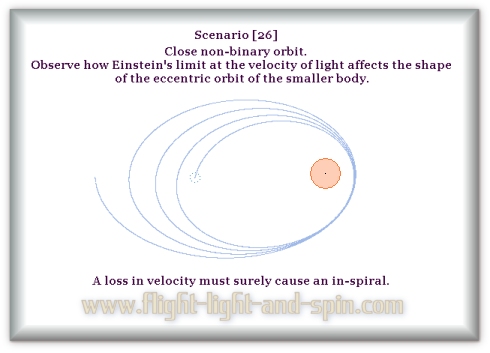Conclusions of Jonathan Ainsley Bain's LIGO analysis
|
| 7 | ||
|
So
as regards binary star-systems, it seems almost certain that if gravity
moves at the velocity of light, then the binary will spiral outwards
and cease to exist. The life-span will vary depending on starting
distance and mass of the pair, but in astronomical time-frames binary
star-systems should be a brief and rare anomaly, unless gravity is
instant. The algorithmic geometry in the previous section makes this
almost perfectly clear. The
contradiction between LIGO and BOGVOS
remains another terrific surprise. I did not anticipate that a delay
in gravity would have such an overwhelming out-spiral on a binary
orbit. That the conclusion to this chapter is not just an outright
contradiction, but more than a dozen computationally necessary disagreements
with the Abbot article, General Relativity itself, and much of the
last 100 years of Astrophysics as well; is hardly ideal, and yet enthralling
all the same. |
||
|
In
chapter XX on quantum gravity the affect of Einstein’s theory
on the orbit of Mercury was inconclusively discussed. But as was pointed
out earlier: Einstein’s theory on the limit at the velocity
of light will cause a reduction in expected velocity when compared
with the Newtonian laws. Surely a reduction in velocity can only cause
an in-spiral? Scenario [26] reveals an astonishing piece of geometry:
I
see no evidence to suggest that these avenues have been satisfactorily
explored before now within evolutionary algorithms. The more questions
this unearths, the murkier the horizon gets; and I’m not sure
where this inquisition will lead to. |
||
|
But I have to reiterate the point from the previous chapter, that ‘black-holes’ can not exist. Instead such super-dense bodies could be termed ‘Chandrasekhar Stars’, or C-stars. The term ‘black-hole’ is so loaded with contradictions that its only usage should be in the historical context. It has no place in any study which upholds the integrity of logic as a foundational fundamental premise of knowledge. The establishment has for the better part of the last century failed to realize that gravity as curved space from General Relativity is entirely contrary to black-holes. If gravity curves space such that nothing traveling at the velocity of light could escape this curved space, then the black-hole would give off zero gravity. The gravitational-wave itself is supposedly traveling at the velocity of light, and so it could not escape the hole that it itself has generated! This is such an overwhelming oversight by the establishment, that I feel totally confident that this-here analysis is a vast improvement; albeit imperfect itself. There is another more obvious problem with the neo-Relativistic paradigm in the context of the LIGO claims regarding GW150914. You see, at the event horizon of a black hole time itself is said to stop due to excessive gravity according to General Relativity. So there is no way that the event horizons of two ‘black holes’ could merge. An orbit
requires time to be moving, whereas for a ‘black hole’
time has to come to a standstill. A ‘black-hole’ could
not spin for this very same reason. Neither could those two event
horizons orbit one another, as this would also require time to be
moving. So as the two event horizons moved closer together, they would
be perceived to slow down as time is altered according to standard
theories on black holes. And yet the LIGO data claims the entirely
contradictory conclusion that they accelerated just before the merger,
whilst being said to be in keeping with standard interpretations of
General Relativity. |
||
| So before construction on the next simulator begins, I don’t want to leave the LIGO-BOGVOS contradiction completely unresolved for the reader either. I thus offer a few potential theories to attempt resolution for the LIGO-BOGVOS contradiction. Perhaps the LIGO data is not actually only measuring the force of gravity. If one takes it as a certain empirical premise that the 7 milliseconds difference between the LIGO readings is correct; then combine that with the certain logical premise that gravity cannot propagate as slowly as light because of BOGVOS then a rational conclusion could be that the observed oscillation is not gravity, but instead an electromagnetic pull. Now the LIGO group seem to claim that this possibility cannot be, but if they have excluded all electromagnetic activity from their detector, then it has to be noted that the Earth itself is made up of large amounts of iron, so if the detector is unmoved, and the entire Earth is wobbled by an electromagnetic pull, then the net result will be an oscillation of the detector! They cannot insulate the entire Earth! I will continue with this most intriguing possibility at the end of the chapter. So the conclusion to this analysis is simply that Einstein’s Relativistic adjustments as regarding gravity are quite contrary to ordinary empirical observation. The only valid adjustment to Newtonian gravity is that of quantum time from Planck. Gravity is either an instantaneous force, or it is propagated so many times faster than the velocity of light as to be considered virtually instantaneous. Even
the limit at the velocity of light is at best a crude approximation.
But certainly, binary orbits will fall apart with a velocity of gravity,
and the LIGO data could never be a pair of black-holes spiraling inwards
due to General Relativity. |
||
|
|||||
^ Top of Page ^
